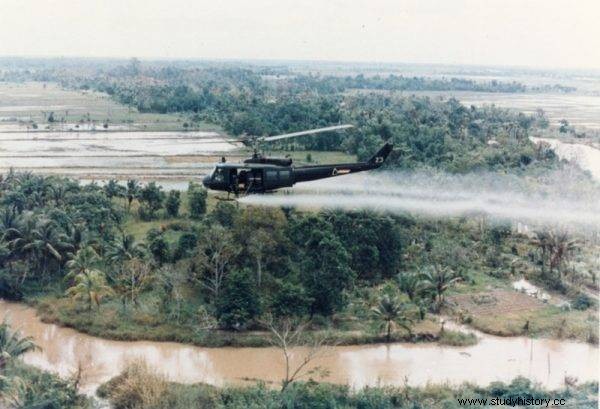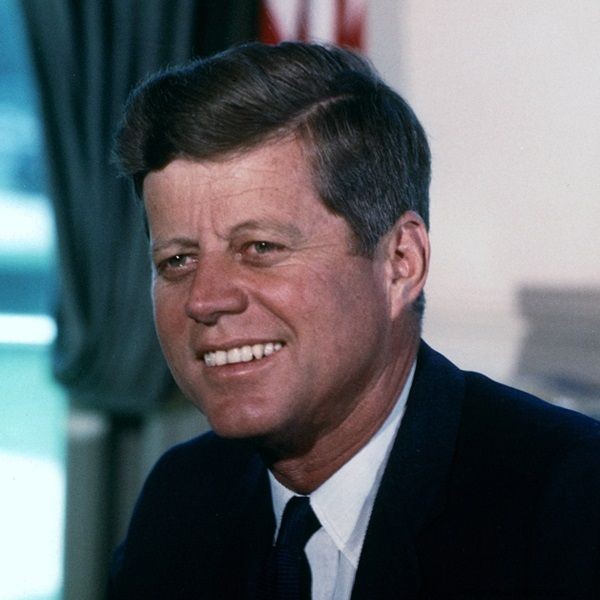Rainbow herbicides were a way for the US military to fight Vietcong. As it soon turned out, the chemicals destroyed much more than just the leaves.
US forces faced not only strong resistance from the Vietcong jungle in the Vietnamese jungle, but a surprisingly formidable environment. Vietnamese soldiers used the vegetation very effectively in the fight against the invaders, they knew it much better and were adapted to the harsh climate. This allowed for extremely effective ambushes, approaching US camps unnoticed and concealing operational bases. On the other hand, Americans could not use heavy equipment and had to rely on infantry, which was confused and endlessly trapped. In addition, the transport logistics were difficult and the air support less accurate.

American helicopter splashing "Agent Orange"
That is why the US military had to use all possible means. The most effective and at the same time one of the most controversial weapons in the arsenal were chemical defoliants, called rainbow defoliants due to the naming of individual herbicides. Their action was to destroy vegetation which lost leaves after spraying.
How to prevent forests
For the first time and with great success, these measures were used by the British army during the suppression of the Malay Uprising, when ambushes for convoys posed a great threat due to the vegetation favorable to the insurgents. South Vietnamese forces asked the US to defoliate. On November 30, 1961, President John F. Kennedy authorized the use of herbicides. The operation was called Ranch Hand and was given two main goals: to deprive the enemy of his natural hiding place and to cut off his food source by destroying crops.

On November 30, 1961, President John F. Kennedy authorized the use of herbicides
After successful tests, on January 7, 1962, the first six Fairchild C-123 transport aircraft adapted for chemical spraying landed at the Vietnam base. Six days later, Operation Ranch Hand began. A number of air bases in the conflict area were used as operational bases. By default, 3 to 5 planes in the formation departed simultaneously, each spraying an area approximately 80 meters wide by 16 kilometers long. After the incident in the Gulf of Tonkin, when the US officially entered the conflict, the spraying intensity was increased significantly. In 1968 alone, 57,000 flights were carried out, splashing more than 19 million liters, over an area of approximately 20,000 square kilometers.
95% of the missions were performed by Fairchild planes. They were dangerous:you had to fly very low, about 150 feet above the ground, and slowly - 130 miles per hour in a straight line. It is difficult not only from a piloting point of view. Airplanes moving in this way are very vulnerable to anti-aircraft fire. The most demanding missions took place in zone D, where limited space and small targets forced diving maneuvers. There, also modified Bell UH-1 helicopters were used. The ground was also sprayed from trucks and hand sprayers, especially near US military bases.
The strongest color
Until 1966, green, pink and purple agents were used, which were later replaced by the more effective ones - orange and, to a lesser extent, white. Agent Orange was essentially a mixture of two herbicides:2,4,5-Ttrichlorophenoxyacetic acid and 2,4-Dichlorophenoxyacetic acid. Both were tested during the Second World War and were planned to be used against Japan. The spraying caused the leaves to dry out, which shed after 3 to 8 weeks and did not regrow for another 4 to 6 months. As Agent Orange is fat-soluble, it is difficult to wash off with water after spreading, so the rains did not remove it from the vegetation. Jungle defoliation missions used 13 to 55 times higher doses than crops destruction.

As a standard, 3 to 5 planes in the formation departed simultaneously, each spraying an area approximately 80 meters wide by 16 kilometers long.
The most dangerous thing about the orange, however, was its by-product:2,3,7,8-Tetrachlorodibenzodioxin, or TCDD for short. Toxic to humans, causes in direct contact disorders of hemoglobin production, pancreatitis, liver damage, increases susceptibility to infections, and also disrupts the work of the nervous and endocrine systems. People exposed to the substance are more likely to develop cancer, and their offspring are more likely to become deformed. It was because of these properties that Operation Ranch Hand was eventually completed. Of great importance was the research of the US National Cancer Institute, which showed the enormous impact of Agent Orange on human health.
Soldier safe but sick
The protests led to the final decision to end the operation. The last flight took place on January 7, 1971. In total, approximately 31,100 liters of green agent, 465,380 liters of pink agent, 549,550 liters of purple, 8,211,630 liters of blue (used for liquidation of crops), 20,200,140 liters of white and 44,391,740 liters of orange were sprayed. The sprayed area is approximately 77,000 square kilometers of forest and farmland (of which approximately 60% with the orange measure). The military assessed the results of the operation very positively:horizontal visibility increased by an average of 70%, vertical visibility by 90%, which was of great importance for the safety of American soldiers and their effectiveness. But in reality the numbers remained only numbers. The Viet Cong continued to find new hiding places and ways to harass invaders, and the atmosphere of eternal tension did not disappear from military bases.
Even though dioxin has a soil life of around 3 to 5 years, the losses to the ecosystem have been enormous. It was only in the mid-1980s that the environment began to recover after systematic afforestation campaigns.
But the most tragic effects of using TCDD on Agent Orange and other "rainbow" agents have left their mark on humans, as documented by numerous studies. According to Vietnamese studies, exposure to Agent Orange has caused health problems for around 3 million inhabitants. Of these, 400,000 died or were permanently maimed. About 500,000 babies born immediately after Ranch Hand surgery were deformed. The period of decay in the human body is about 20 years and it is believed that Agent Orange caused genetic damage to the populations inhabiting the most bombarded areas, the effects of which can be seen for many years to come.

Major Tự Đức Phang was exposed to dioxin contaminated Agent Orange.
American and South Korean veterans also suffered from health. The soldiers employed in mixing the ingredients of the fluid and spraying it from ground level were assured that there were no negative health effects. But after returning from the war, many experienced health problems and had deformed offspring.
Bibliography:
- Langer, H., Vietnam War. An Encyclopedia of Quotations . ABC-CILCO, 2005.
- Witkiewicz, Z., 1000 words about chemistry and chemical weapons:collective work . Warsaw:Publishing House of the Ministry of National Defense, 1987.
- The legacy of Agent Orange . Video Material, News.bbc.co.uk, 2005.
